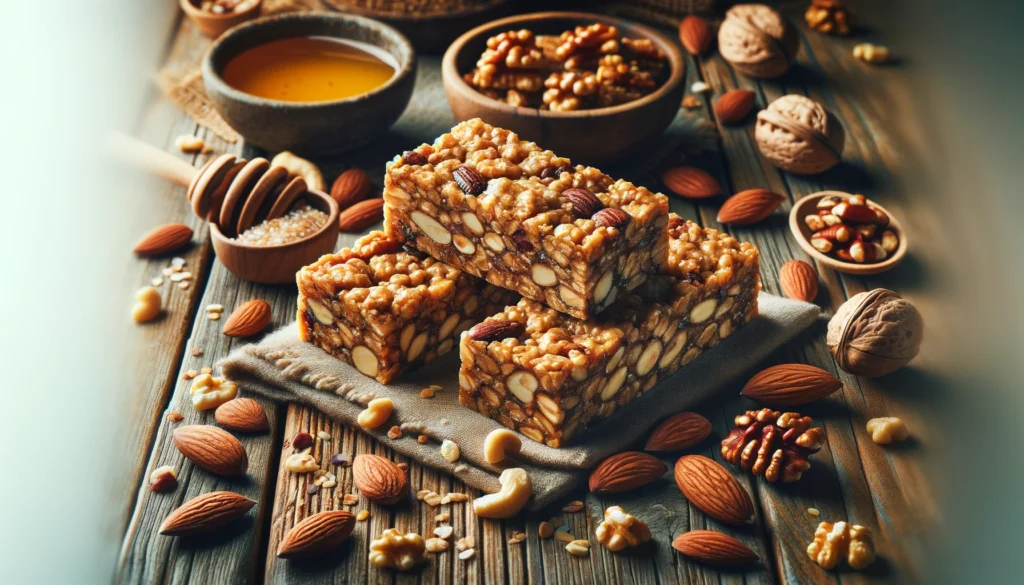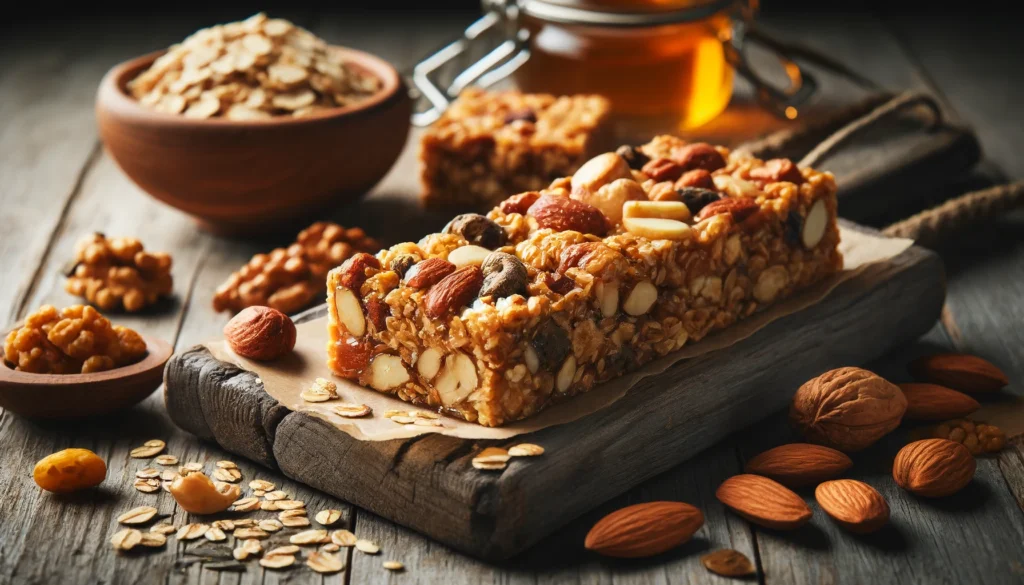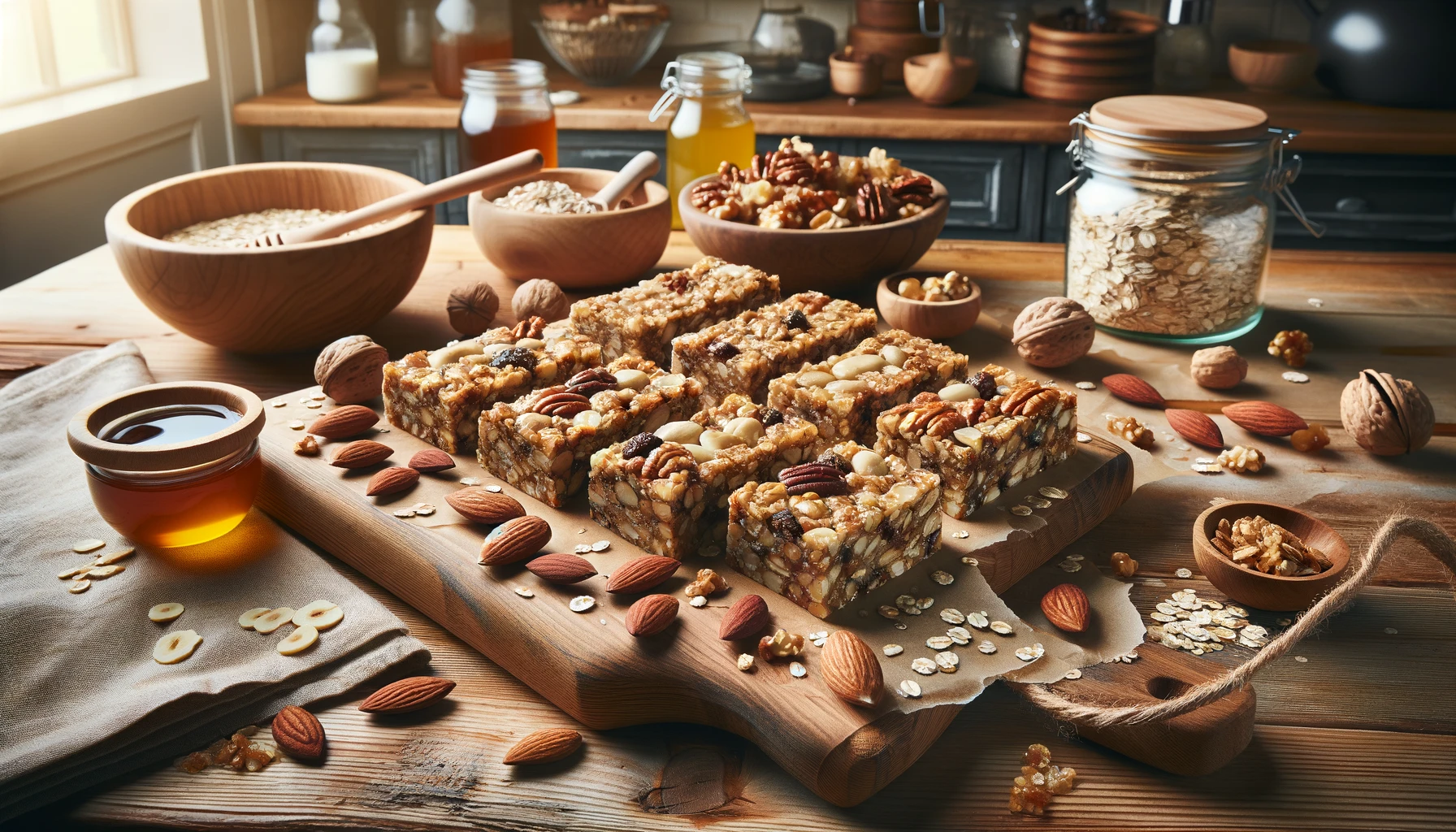Making granola bars at home offers a myriad of benefits, ranging from customizing ingredients to suit dietary needs and flavor preferences to controlling the sugar content and avoiding artificial additives. By crafting your own granola bars, such as Homemade Nutty Granola Bars, you can ensure they are packed with wholesome ingredients and free from unnecessary fillers.
Homemade Nutty Granola Bars are a delightful treat that combines the heartiness of oats, the crunch of nuts, and the natural sweetness of honey. These bars are not only delicious but also packed with nutrients like fiber, protein, and essential minerals.
Moreover, homemade granola bars, such as “Homemade Nutty Granola Bars,” are incredibly versatile. You can add dried fruits, seeds, or spices to enhance flavor and nutritional value. Plus, they’re cost-effective, often more affordable than store-bought options, especially when bought in bulk.

Primary Ingredients:
- Oats: Rolled oats are typically used in chia pudding recipes. They provide a creamy texture and are a good source of fiber. Steel-cut oats can also be used but may require longer soaking or cooking times.
- Various Nuts: Nuts like almonds, cashews, or pecans can add crunch and flavor to chia pudding. They are often used as toppings or blended into the pudding for added creaminess.
- Honey: Honey is a common sweetener used in chia pudding recipes. It adds a natural sweetness and depth of flavor. However, it can be substituted with other sweeteners like maple syrup, agave nectar, or date syrup for a vegan option.
Substitutions for Dietary Restrictions:
- Nut-Free: To make the chia pudding nut-free, you can omit nuts altogether or use seeds like sunflower seeds, pumpkin seeds, or sesame seeds for a similar crunch and texture. Alternatively, you can use toasted coconut flakes for a nut-like flavor.
- Vegan: Chia pudding is naturally vegan-friendly, but if honey is used as a sweetener, it can be replaced with maple syrup, agave nectar, or date syrup. Non-dairy milk such as almond milk, coconut milk, or soy milk can be used as a substitute for cow’s milk.
- Gluten-Free: Oats are naturally gluten-free, but make sure to use certified gluten-free oats if you have a gluten sensitivity or allergy. Ensure that other ingredients used, such as toppings or sweeteners, are also gluten-free.
- Low-Sugar: If you’re looking to reduce sugar content, you can use stevia, erythritol, or monk fruit sweetener instead of honey or maple syrup. Be mindful of the amount used, as these sweeteners are often much sweeter than sugar.
Preparation: Ingredients and Tools Needed
Ingredients:
- 2 cups rolled oats
- 1/2 cup nuts (almonds, walnuts, or your choice)
- 1/2 cup seeds (sunflower, pumpkin, or a mix)
- 1/2 cup dried fruits (raisins, cranberries, or apricots, chopped)
- 1/2 cup honey or maple syrup
- 1/4 cup coconut oil or butter
- 1/4 cup brown sugar (optional for added sweetness)
- 1 teaspoon vanilla extract
- 1/2 teaspoon salt
Tools:
- Mixing bowls
- Baking pan or sheet
- Parchment paper or silicone baking mat
- Saucepan
- Spatula
- Knife (for chopping fruits if needed)
Step-by-Step Instructions
Preheat the oven to 350°F (175°C) and line a baking pan with parchment paper or a silicone baking mat.
2. Mix dry ingredients: In a large bowl, combine oats, nuts, seeds, and dried fruits. Mix well.
3. Heat wet ingredients: In a saucepan over medium heat, combine honey or maple syrup, coconut oil or butter, brown sugar (if using), vanilla extract, and salt. Heat until everything is melted and well combined, stirring occasionally.
4. Combine wet and dry ingredients: Pour the wet mixture over the dry ingredients. Stir until everything is evenly coated.
5. Press into pan: Pour the mixture into the prepared pan. Use a spatula or your hands to press it down firmly and evenly.
6. Bake: Bake in the preheated oven for 20-25 minutes, or until the edges are golden brown.
Allow the bars to cool completely in the pan. Once they have cooled, use a sharp knife to cut them into bars or squares.

Tips for Achieving the Perfect Texture
- Mixing: Be gentle when mixing to avoid breaking up the ingredients too much.
- Pressing: Press the mixture firmly into the pan to help the bars hold together better.
- Cooling: Let the bars cool completely before cutting to allow them to set properly.
- Variations: Feel free to add in other ingredients like chocolate chips, coconut flakes, or spices for different flavors.
Enjoy your homemade granola bars as a healthy snack or breakfast on the go!
Customization Ideas
Granola bars are incredibly versatile, making them ideal for customization to suit your tastes and dietary preferences. Here are some ideas to personalize your granola bars, such as Homemade Nutty Granola Bars:
Dried Fruits: Add sweetness and chewiness with dried fruits like raisins, cranberries, apricots, or chopped dates. These also provide extra fiber and nutrients. Consider blending these fruits in a Nutty Granola Bar for a satisfying snack.
Nuts and Seeds: Boost the protein and healthy fats by incorporating nuts and seeds. Almonds, walnuts, pecans, sunflower seeds, pumpkin seeds, and chia seeds are all great options. Toasting them beforehand can enhance their flavor. Learn more about using seeds in our Healthy Veggie Omelette Recipe.
Spices: Add warmth and complexity with spices like cinnamon, nutmeg, ginger, or cardamom. These can complement the sweetness of the bars, much like they do in our Banana Protein Pancakes.
Nut Butters: Incorporate nut butters like almond, peanut, or cashew for richness and added protein. They also help bind the ingredients together, similar to their use in various Healthy Breakfast Options.
Chocolate: For a decadent touch, mix in chocolate chips or chunks. Dark chocolate adds antioxidants and a deep flavor.
Coconut: Toasted coconut flakes can add a tropical twist and a crunchy texture.
Protein Powder: If you want to increase the protein content, consider adding a scoop of your favorite protein powder. Ensure it complements the other flavors.
Flavor Extracts: Vanilla, almond, or coconut extracts can add a burst of flavor without extra calories.
Sweeteners: Customize the sweetness level by using honey, maple syrup, agave nectar, or brown rice syrup. Adjust the amount based on your taste preferences.
Cereal or Pretzels: For added crunch, consider mixing in some crushed cereal or pretzels
Health benefits of key ingredients
Granola bars can offer a range of health benefits, depending on their ingredients. Here are some key ingredients and their nutritional benefits:
- Oats: Oats are a great source of fiber, which can help regulate digestion, lower cholesterol levels, and keep you feeling full longer. They also provide complex carbohydrates for energy.
- Nuts and Seeds: Nuts and seeds are rich in healthy fats, protein, fiber, vitamins, and minerals. They can help lower cholesterol, reduce inflammation, and support heart health.
- Dried Fruits: Dried fruits add natural sweetness and provide vitamins, minerals, and antioxidants. They can improve digestion and provide a quick source of energy.
- Honey or maple syrup provide natural sweetness without refined sugars, and they offer antioxidants and potentially antibacterial properties.
- Dark Chocolate: Dark chocolate is rich in antioxidants and may improve heart health by lowering blood pressure and improving blood flow.
Granola bars can fit into a balanced diet when consumed in moderation and as part of a varied diet. They can be a convenient snack option, providing energy and nutrients. However, it’s important to choose bars that are low in added sugars and high in fiber and protein to help keep you satisfied and prevent blood sugar spikes. Pairing a granola bar with a source of protein, such as yogurt or a hard-boiled egg, can make it a more balanced snack. As with any food, it’s best to enjoy granola bars as part of a well-rounded diet that includes a variety of fruits, vegetables, whole grains, lean proteins, and healthy fats. Homemade Nutty Granola Bars are a great option, as you can control the ingredients and ensure they meet your nutritional preferences.
Common Mistakes and Troubleshooting
1. Bars Not Sticking Together: If your bars are not holding together, it could be due to not enough binding ingredients. Try adding more honey, maple syrup, or nut butter to help bind the ingredients together. Pressing the mixture firmly into the pan can also help.
2. Bars Too Dry: Bars can become too dry if they are overbaked or if there is not enough moisture in the recipe. To fix this, try reducing the baking time slightly or adding a bit more honey, maple syrup, or a splash of milk to the mixture before baking.
3. Adjusting Baking Times: Baking times can vary based on your oven and the thickness of your bars. Always check your bars a few minutes before the recommended baking time is up to prevent overbaking. The bars should be lightly golden on top and slightly firm to the touch.
4. Adjusting Ingredient Ratios: If your bars are too dry or too wet, you may need to adjust the ratios of the dry and wet ingredients. For drier bars, try reducing the amount of oats or flour. For wetter bars, add more dry ingredients or reduce the amount of liquid ingredients.
5. Cooling and Setting: Allow your bars to cool completely in the pan before slicing. This will help them set and hold together better. If you try to slice them while they are still warm, they may crumble.
6. Storage: Proper storage can also affect the texture of your bars. Store them in an airtight container at room temperature for up to a week, or freeze them for longer storage.
Best practices for storing Homemade Nutty Granola Bars to maintain freshness
To maintain the freshness of homemade granola bars, follow these tips:
- Storage Containers: Use airtight containers or resealable bags to store granola bars. This helps prevent moisture and air from getting in, which can make the bars stale.
- Room Temperature: Store granola bars at room temperature in a cool, dry place. Avoid storing them in direct sunlight or near sources of heat, as this can cause them to become too soft or sticky.
- Refrigeration: If your kitchen is particularly warm or humid, you may opt to store your granola bars in the refrigerator. This can help prolong their freshness and prevent them from becoming too soft.
- Freezing: Granola bars can also be frozen for longer-term storage. Wrap them individually in plastic wrap or foil, then place them in a resealable freezer bag. They can be kept in the freezer for up to 3 months.
- Thawing: When ready to eat, let frozen granola bars thaw at room temperature for about 15-20 minutes, or microwave them for a few seconds to soften them up.
Following these tips can help ensure that your homemade granola bars stay fresh and delicious for as long as possible.
External Links
- Whole Grains Council – “benefits of whole grains”
- National Honey Board – “using honey in recipes”
- Food Allergy Research & Education – “managing food allergies in homemade recipes”

